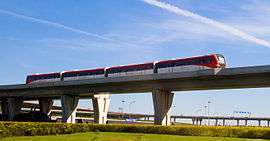Beijing Subway rolling stock


%E5%88%97%E8%BB%8A.jpg)


All Beijing Subway trains run on 1,435mm standard gauge rail and draw power from the 750 V DC third rail, except those on Lines 6 and 14, which use 1,500 V DC overhead wires.[1] Lines 6, 15, Fangshan, and Changping have a designed maximum service speed of 100 km/h.[2] The Airport Line is linear motor driven with a designed maximum service speed of 110 km/h[3][4] All other Lines have a maximum service speed of 80 km/h. Currently Lines 1, 2, 4, 5, 8, 9, 10, 13, 15, Batong, Daxing, Changping, Fangshan, and Yizhuang use 6 car B size trains. Initially, Lines Batong and 13 was originally used 4 car trains and now expanded into six.[5][6][7]
Manufacturers

From the subway's inception to 2003, all Beijing subway trains were manufactured by the Changchun Railway Vehicles Company Ltd., now a subsidiary of the China CNR Corporation. All rolling stock on Lines 2, 5, 6,[8] 9, 10, 13, 15, Yizhuang, Airport and some of Line 1 and 14 stocks[3][9][10] are produced by CNR.[11] However, Qingdao Sifang Locomotive & Rolling Stock Co., Ltd., a subsidiary of China South Locomotive and Rolling Stock Corp. has recently produced rolling stock for the Beijing subway. CSR produced all the trains for Lines 4,[12][13] 8, Daxing,[13] Changping[14] and newer batches of trains for Line 1[15] and 14.[9][16][17]
The Beijing Subway Rolling Stock Equipment Co. Ltd., a wholly owned subsidiary of the Beijing Mass Transit Railway Operation Corp., provides local assemblage, maintenance and repair services.
Models
First Generation
In the 1960s to mid-1970s, the Beijing Subway used DK2 and DK3 models made in Changchun. The DK stands for diandong keche or electrically-operated passenger car.[18] These models and their derivatives, the DK3G, DK20, DK16A, BD1 and BD2 are classified by the Beijing Subway as the first generation.[19] In recent decades, the Beijing Subway Rolling Stock Equipment Co. refurbished the DK16A and DK20 models, which remained in use well into the first decade of the 21st century.[20] The refurbished DK16AG trains entered into service on Line 2 in 2005.[21]
Second Generation
From the 1980 to the early 1990s, the subway introduced several new models including the DK6, DK9 and their derivatives the DK11, DK16 and GTO.[22] The M-series trains that appeared on Lines 2 and 13 were made by Japan's Tokyu Car Corporation.[23][24][25]
Third Generation
In 1998, the subway began deploying a new generation of train sets that featured variable voltage variable frequency (VVVF) control mechanisms. These models include the DKZ4, DKZ5, and the DKZ6.[26] DKZ stands for diandong keche zu or electric passenger train sets.[18] The Changchun RVC also made 174 DK28-DK31 metro cars, which uses VVVF inverters and AC motors for Line 1,[27] and 136 DK32-34 trains for Line 13.[28] In 2005, Line Batong began using SFX01 and SFX02 trains made by Qingdao Sifang.[18] The 40 trains of the Airport Express were made by a joint-venture between the Changchun RVC and Bombardier Transportation, and uses Bombardier's Advanced Rapid Transit (ART) Mark II technology.[25][29]
References
- ↑ "交通委谈轨道交通14号线西段开通试运营情况". 2013-04-16. Retrieved 2013-05-06.
- ↑ New Beijing subway to ease traffic congestion, Wu Wenjie, deputy director of China Railway Tunnel Group, China Daily. Reporter ZHENG Xin. 2012-11-26.
- 1 2 "Linear Motor Commuter for Beijing" CNR website Accessed Mar. 27, 2010
- ↑ "机场线轨道车辆有哪些先进设计?". 2008-08-22. Retrieved 2009-11-27.
- ↑ "北京地铁2号线全部更换空调车 八通线扩编完成". 2008-08-08. Retrieved 2009-08-02.
- ↑ "北京地铁流量迫近400万 计划新车上线城铁扩编". 2008-07-09. Retrieved 2009-02-04.
- ↑ "13号线列车扩改任务全部完成 增至六节车厢". 2009-03-26. Retrieved 2009-08-02.
- ↑ "北京地铁6号线斥资30亿购进512辆新车". 2011-01-30. Retrieved 2011-02-04.
- 1 2 涂露芳 (2012-12-09). "14号线大容量新车下线". Retrieved 2013-05-06.
- ↑ (Chinese) 吉林日报 Archived March 3, 2014, at the Wayback Machine. July 31, 2009
- ↑ ""北车制造"北京15号线和亦庄线地铁同日开通". 中国北车股份有限公司. 2010-12-31. Retrieved 2011-02-03.
- ↑ "向共和国60华诞献礼 南车造地铁在京投入运营". 中国南车股份有限公司. 2009-09-28. Retrieved 2009-11-27.
- 1 2 "南车中标北京地铁大兴线". 2009-07-31. Retrieved 2011-02-03.
- ↑ "时速100公里地铁车辆在中国南车下线". 2010-09-08. Retrieved 2011-02-03.
- ↑ "北京地铁一号线新型列车亮相". 新浪网. 2007-09-21. Retrieved 2009-11-27.
- ↑ (Chinese) Archived July 8, 2011, at the Wayback Machine. July 30, 2009
- ↑ (Chinese)"青岛造" 最高运营时速100公里 Dec. 31, 2009
- 1 2 3 "Robert McConnell's Beijing Subway Webpage" Accessed Mar. 27,2010
- ↑ (Chinese) 第一代电动客车 Archived December 31, 2009, at the Wayback Machine. Accessed Mar. 27, 2010
- ↑ (Chinese) 厂修车介绍 Archived December 31, 2009, at the Wayback Machine. Accessed Mar. 27, 2010
- ↑ (Chinese)DK16大修改造车 Accessed Mar. 27, 2010
- ↑ (Chinese) 第二代电动客车 Archived December 31, 2009, at the Wayback Machine. Accessed Mar. 27, 2010
- ↑ (Chinese) "东急" Archived April 17, 2016, at the Wayback Machine. Accessed Mar. 28, 2010
- ↑ (Chinese) "M车" Archived December 31, 2009, at the Wayback Machine. Accessed Mar. 28, 2010
- 1 2 "Nanyue Express"
- ↑ (Chinese) Archived December 31, 2009, at the Wayback Machine. Accessed Mar. 27, 2010
- ↑ "DK28 Metro Car with VVVF Inverter" Accessed Mar. 27, 2010
- ↑ "DK32 Commuter Train for Beijing" Accessed Mar. 27, 2010
- ↑ "Bombardier Awarded Contract in China for the Beijing Capital International Airport Link With Connection to Summer 2008 Olympic Games Village" Business Wire Mar. 20, 2006
External links
| Wikimedia Commons has media related to Beijing Subway rolling stock. |
